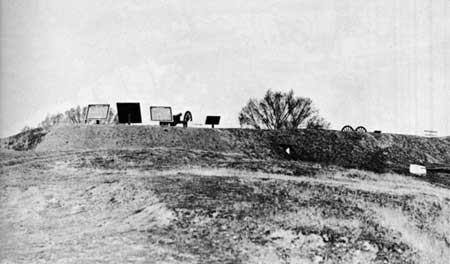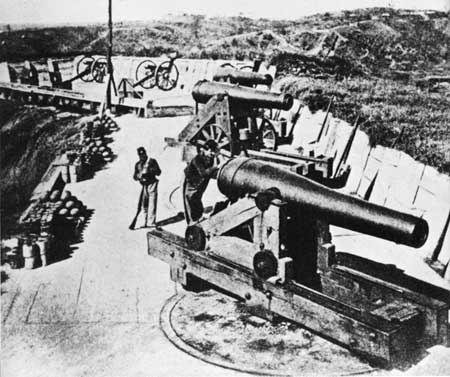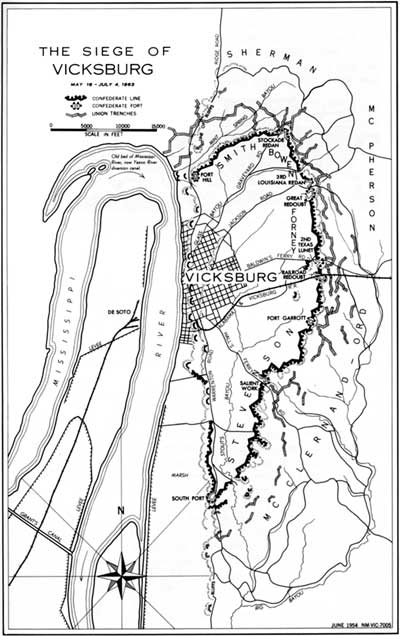|
VICKSBURG National Military Park |
 |

Confederate Railroad Redoubt. Plaques mark angle where fort wall
was breached and entered by Union troops during the assault of May 22,
1863.
The Siege of Vicksburg (continued)
THE ASSAULT OF MAY 22. While the probing operation of the 19th had failed, Grant further considered the important results which a successful assault would achieve. Such a move, however costly, would save a long siege. In the end, fewer men might be lost, and a growing threat to the Union rear—General Johnston raising troops near Jackson for the relief of Vicksburg—could be eliminated by quickly capturing Vicksburg and throwing the entire Union strength against Johnston. In addition, the Federal troops, spirited by recent victories and impatient to seize the prize for which they had campaigned so long, would not work so zealously in the trenches with pick and shovel unless assault had failed. On the 21st, Grant issued orders for a general assault against Vicksburg the following day.

The heavy guns of this Union siege battery were
borrowed from the Federal gunboats and used against the Confederate
siege defenses.
From Photographic History of the Civil
War.

(click on image for an enlargement in a new window)
The Union assault of May 22 was delivered against the center of the Confederate siege line along a 3-mile front from Stockade Redan to Fort Garrott. The felled trees and thick undergrowth, as well as the precipitous faces of the ravines, restricted the scope of Union maneuver. Only a portion of Grant's full strength could be brought into action, reserves being posted to exploit a breakthrough. Careful preparations preceded the attack: field batteries were run forward and emplaced to provide a covering fire for the infantry, and troops were advanced into concealed positions—in places, within 200 yards of their objective. Watches of all Union commanders were synchronized, the attack to begin simultaneously at 10 a. m. in order to prevent Pemberton from shifting his forces from one threatened point to another.
Of the six forts in the area of the grand assault, the Stockade Redan, under attack by Maj. Gen. Frank Blair's Division of Sherman's Corps, exemplified the day's action in method and result. Blair's men were faced with two formidable obstacles: the fort could be reached only by way of the Graveyard Road because of the deep ravines bordering the road, and the road was completely covered by the guns of the fort. In front of the fort was a deep ditch which protected it from attempts to climb the wall and enter the works. The night before, Sherman had decided that a bridge would be needed by his men to span the ditch. Only one source of lumber could be found—a frame house in which General Grant was sleeping. Informed of the need, Grant dressed and watched the house quickly torn down for bridging materials.
At the stroke of 10, the artillery bombardment of the fort ceased and the "Forlorn Hope"—a volunteer company of 150 men—raced from their position over the Graveyard Road toward the Stockade Redan, carrying the planks to bridge the ditch for the regiments to follow. Until the Federal troops almost reached the Confederate line, there was no sign of its defenders. Then the Southern soldiers "rose from their reclining position behind the works, and gave them such a terrible volley of musketry" that the road soon was nearly obstructed by the bodies of the killed and wounded, "the very sticks and chips, scattered over the ground jumping under the hot shower of Rebel bullets."
Although two color-bearers climbed the wall of the fort and planted their flags near the crest, the remnants of regiments which reached the ditch were unable to storm the walls and enter the redan. Attempting to prevent the fort garrison from firing down into the ditch, the Federal infantry swept the top of the wall with rifle fire. The toll was costly among the Confederate defenders, who fought back, using artillery shells as hand grenades and rolling them down among the Union troops in the ditch. After 4 hours of fighting, the attack was stalemated at Stockade Redan.
Union flags were placed also on the walls of the Great Redoubt and Second Texas Lunette, but it was at the Railroad Redoubt that a momentary breach was made in the Confederate defenses. Here, McClernand's men reached the fort in force, and Sgt. Joseph E. Griffith and several comrades of the 22nd Iowa crawled through a gap in the wall, which had been blasted by Union artillery, and entered the outer works. All were shot down but Griffith. He was able to back out through the opening, bringing a dozen prisoners with him. When the Union assault threatened to engulf the fort, there was a call for Confederate volunteers to regain the lost ground. A volunteer company from the Texas Legion counterattacked and drove the Union troops from the outer defenses.
Encouraged by his partial success, McClernand asked Grant for reinforcements and a renewal of the attack which, he felt, would enable his men to break the Confederate line. Grant ordered Sherman and McPherson to commit their reserves and create a diversion in McClernand's favor. The renewed assault was shattered by the resolute Confederate defense. It served only to increase Union losses and to intensify an already bitter controversy over McClernand's military ability, which eventually resulted in his removal from command and the appointment of Maj. Gen. Edward Ord to head the XIII Corps. More than 3,000 Union soldiers lay dead or wounded in the ditches and on the slopes of the ridge. It was the last assault against Vicksburg.

|
|
Last Modified: Mon, Dec 2 2002 10:00:00 am PDT |


